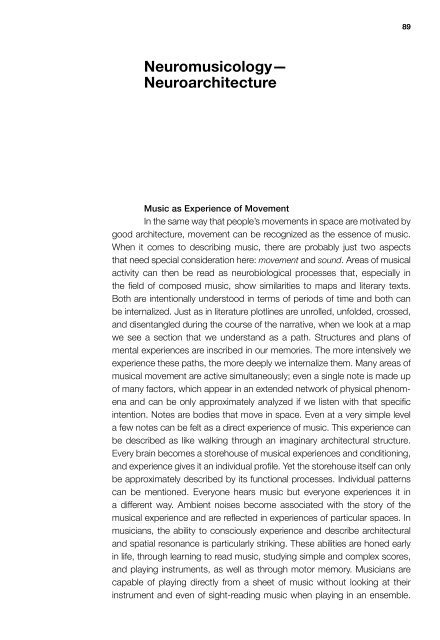Neuroarchitecture
978-3-86859-479-9 https://www.jovis.de/de/buecher/product/neuroarchitecture.html
978-3-86859-479-9
https://www.jovis.de/de/buecher/product/neuroarchitecture.html
Create successful ePaper yourself
Turn your PDF publications into a flip-book with our unique Google optimized e-Paper software.
89<br />
Neuromusicology—<br />
<strong>Neuroarchitecture</strong><br />
Music as Experience of Movement<br />
In the same way that people’s movements in space are motivated by<br />
good architecture, movement can be recognized as the essence of music.<br />
When it comes to describing music, there are probably just two aspects<br />
that need special consideration here: movement and sound. Areas of musical<br />
activity can then be read as neurobiological processes that, especially in<br />
the field of composed music, show similarities to maps and literary texts.<br />
Both are intentionally understood in terms of periods of time and both can<br />
be internalized. Just as in literature plotlines are unrolled, unfolded, crossed,<br />
and disentangled during the course of the narrative, when we look at a map<br />
we see a section that we understand as a path. Structures and plans of<br />
mental experiences are inscribed in our memories. The more intensively we<br />
experience these paths, the more deeply we internalize them. Many areas of<br />
musical movement are active simultaneously; even a single note is made up<br />
of many factors, which appear in an extended network of physical phenomena<br />
and can be only approximately analyzed if we listen with that specific<br />
intention. Notes are bodies that move in space. Even at a very simple level<br />
a few notes can be felt as a direct experience of music. This experience can<br />
be described as like walking through an imaginary architectural structure.<br />
Every brain becomes a storehouse of musical experiences and conditioning,<br />
and experience gives it an individual profile. Yet the storehouse itself can only<br />
be approximately described by its functional processes. Individual patterns<br />
can be mentioned. Everyone hears music but everyone experiences it in<br />
a different way. Ambient noises become associated with the story of the<br />
musical experience and are reflected in experiences of particular spaces. In<br />
musicians, the ability to consciously experience and describe architectural<br />
and spatial resonance is particularly striking. These abilities are honed early<br />
in life, through learning to read music, studying simple and complex scores,<br />
and playing instruments, as well as through motor memory. Musicians are<br />
capable of playing directly from a sheet of music without looking at their<br />
instrument and even of sight-reading music when playing in an ensemble.


















